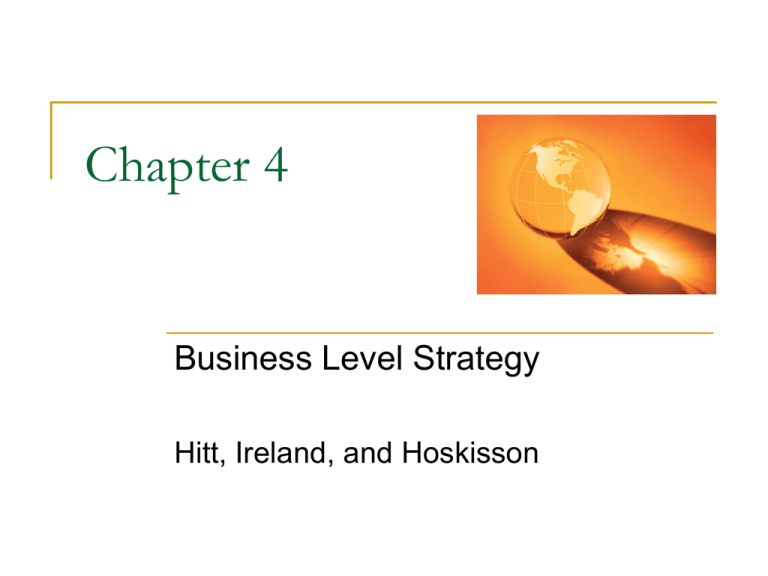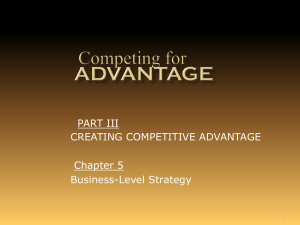PPT Slides
advertisement

Chapter 4 Business Level Strategy Hitt, Ireland, and Hoskisson Business level strategy Definition An integrated and coordinated set of commitments and actions the firm uses to gain a competitive advantage by exploiting core competencies in specific product markets. Copyright © 2008 Cengage Customers Customers are the foundation of successful business-level strategies Firm examines issues of who, what, and how Who are the customer groups to be served What needs those customers have that the firm seeks to satisfy How can the firm use core competencies to satisfy customer needs. Copyright © 2008 Cengage Five business-level strategies Copyright © 2008 Cengage Cost leadership strategy Using a cost leadership strategy, a firm Produces no-frills, standardized products for typical customers Offers these low-cost products with competitive levels of differentiation. Focuses on efficiency so costs are lower than competitors’ costs. Copyright © 2008 Cengage Risks of cost leadership strategy Competitive risks associated with the cost leadership strategy include a loss of competitive advantage to newer technologies a failure to detect changes in customers’ needs, and the ability of competitors to imitate the cost leader’s competitive advantage through their own unique strategic actions. Copyright © 2008 Cengage Differentiation strategy Firms using differentiation strategy Provide products that have different, valued features that are sold at a premium price Differentiate their products along as many dimensions as possible. The less similarity to competitors’ products, the more buffered a firm is from competition with its rivals. Copyright © 2008 Cengage Risks of differentiation strategy Risks Customers decide that the differences between the differentiated product and the cost leader’s product are not worth a higher price Firms can’t sufficiently differentiate a product to create value for which customers will pay a premium price Competitors offer similar products at a lower cost Counterfeiters offer a cheap “knockoff” of a differentiated good or service. Copyright © 2008 Cengage Focus strategies The focus strategy is an integrated set of actions taken to produce goods or services that serve the needs of a particular competitive segment. Firms choose a focus strategy to serve the needs of a specific customer segment or industry segment. Examples a particular buyer group (such as youths or senior citizens) a different segment of a product line (such as products for professional painters or the do-it-yourself group), or a different geographic market (such as East or West in the U.S). Copyright © 2008 Cengage Targeting a specific industry segment Firms can create value for a specific segment of the market by using the focused cost leadership strategy or the focused differentiation strategy. To be successful, firms must have the core competencies required to provide more value to the specific market segment than can competitors serving the entire industry. Copyright © 2008 Cengage Risks of focus strategies Competitive risks of focus strategies A competitor is able to focus on an even more narrowly defined market segment Industry-wide competitors decide to focus on specific customer segments The differences are reduced between the needs of a specific market segment and those of the rest of the industry Copyright © 2008 Cengage Integrated cost leadership/differentiation strategy Using this strategy, firms Provide relatively low cost products with valued differentiated features. Use primary and support activities to produce differentiated products at relatively low costs. Risk of this strategy A firm produces products that lack sufficient low cost or differentiation. Copyright © 2008 Cengage




